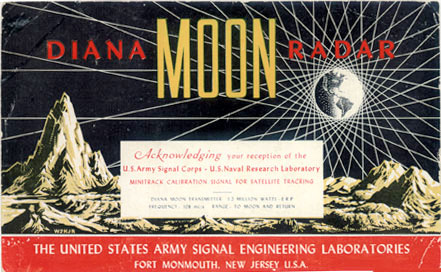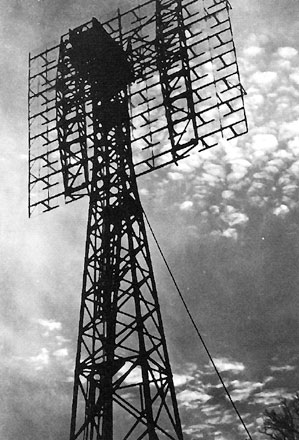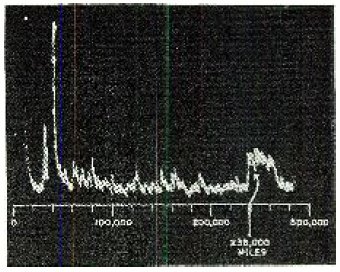The US Army Signal Corps made the first attempt to "touch" another celestial body when on January 10, 1946, it bounced radio signals off the moon and received the reflected signals.
Dubbed "Project Diana" for the Roman moon goddess, the effort led to what is today known as EME (Earth-Moon-Earth) communications, used for ham radio.
 |
||
| QSL card for reception reports. | ||
Project Diana is often noted as the birth of the US space program, as well as that of radar astronomy. The project was the first demonstration that artificially created signals could penetrate the ionosphere, opening the possibility of radio communications beyond the Earth for space probes and human explorers.
Project Diana also established the practice of naming space projects after Roman gods and goddesses, like Mercury and Apollo.
Project Diana's first successful echo detection came on at 11:58 am by John H DeWitt and his chief scientist E King Stodola from a lab at Camp Evans, in Wall Township, NJ.
 |
||
| Project Diana radar antenna, Fort Monmouth, New Jersey. | ||
A large transmitter, receiver, and antenna array were constructed at the lab for the project. The transmitter, a highly modified World War II SCR-271 radar set, provided 3,000 watts at 111.5 MHz in quarter-second pulses, while the "bedspring" dipole array antenna provided 24 dB of gain.
Reflected signals were received about 2.5 seconds later, with the receiver compensating for Doppler modulation of the reflected signal.
 |
||
| Oscilloscope display showing the radar signal. The large pulse on the left is the transmitted signal, the small pulse on the right is the return signal from the Moon. (Photo: Wikipedia) |
||
Attempts could be made only as the moon passed through the 15-degree-wide beam at moonrise and moonset, as the antenna's elevation angle was horizontal. About 40 minutes of observation was available on each pass as the moon transited the various lobes of the antenna pattern.
The Project Diana site is today maintained by the Infoage Science/History Learning Center.